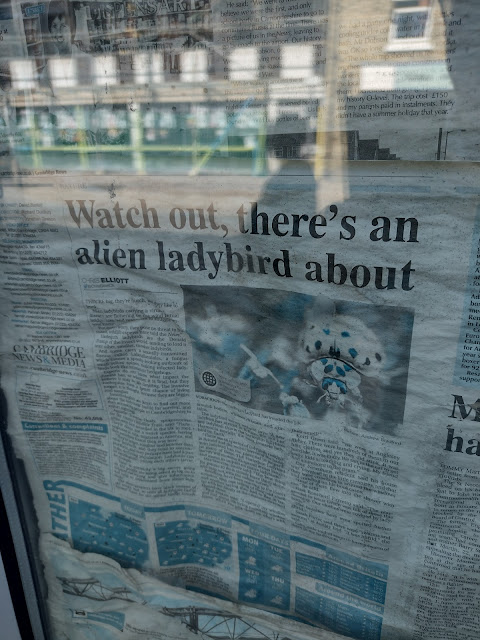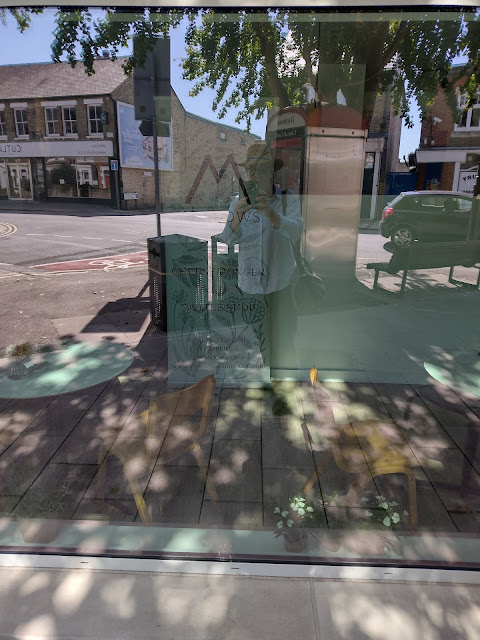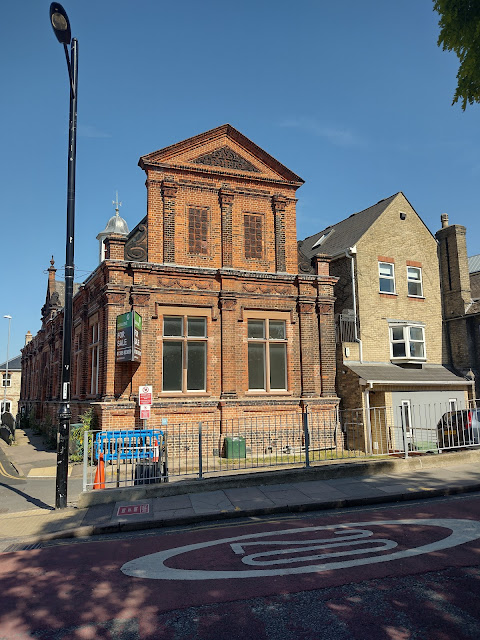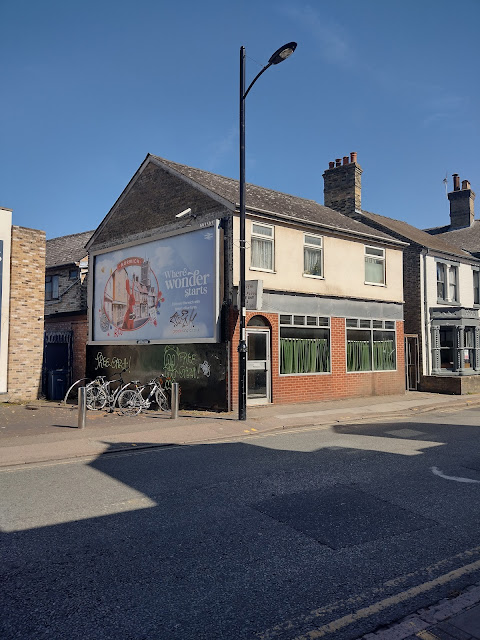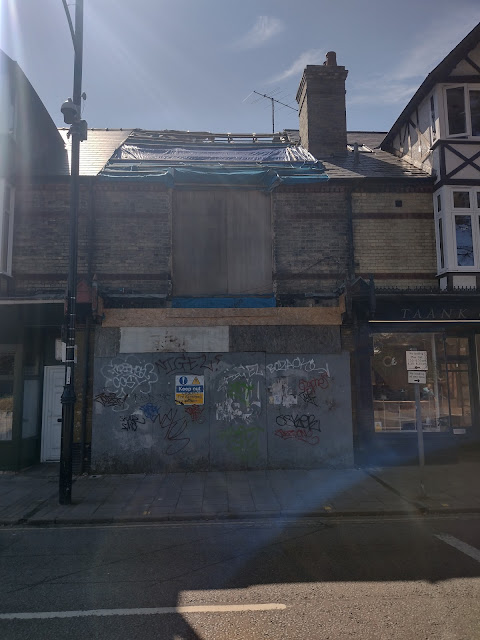I'd noticed scaffolding had gone up in front of the building formerly inhabited by a Tesco. It had been empty for a while, the supermarket oligarch having finally given up the ghost in Mill Road. For many this was a welcome departure. A few years ago, the No Mill Road Tesco campaign was well organised and culminated in a large demonstration. The Tesco opened anyway. But with no alcohol licence and with limited local support, a few short years down the line its not that surprising that it has gone. It had failed to compete with the long standing and more popular Mill Road Co-op. As a 'product' of the Co-op and so having inherited a possibly irrational semi-loyalty to it, I can't say I was sorry to see the back of Tesco. The building had potential. I had hoped that maybe in a street constantly bigging up its community credentials, somebody with more imagination, ingenuity and access to funds than me might come up with a great plan. Maybe some sort of cultural venue, library, community repair shop or centre where people could go and interact without feeling like they have to buy an expensive coffee to pay for their seat.
Of course, nothing of the sort has been proposed. Instead there is currently a planning application for a private MRI scanning facility. I hadn't been that optimistic that what would replace Tesco would be anything to get too excited about. But I had not foreseen something quite as far removed from what- might-have-been as the provision of a private health care facility. This seemed to me something wholly contrary to everything I regarded Mill Road as having once stood for, in particular on the Romsey side of the Bridge.
A bit of cursory investigation revealed the planning application was made by Moor Park Capital Next Gen Ltd. Companies House records show the company is directed by somebody of Australian nationality who is resident in Thailand. The company is owned by Hamersley Private Limited of the British Virgin Islands. Who is behind the BVI company of course is not (and does not have to be) disclosed.
There have already been a few objections lodged against the plans on grounds of noise, traffic and because the proposed development is out of character with the conservation area. The current building can hardly be said to be of architectural merit, but does have essence of Mill Road about it. What the Council's decision will be is anyone's guess. The developers appear to have already started work regardless.
I took a stroll to observe other recent developments. Or more accurately in most cases lack of development. A number of shops that closed have remained dormant for some time, most since before or during the pandemic. They are frozen in time, creating interim liminal points in between the places that have remained active or in some cases been reactivated. These 'closed shops' are left behind in time and have become temporary relics of the 'before times'.
Opposite the former Tesco is a shop unit which has its windows completely covered in newspaper from the inside. It is not possible to see into the interior and no shop sign remains from its previous incarnation. The newspaper, the Cambridge News, dates from 29 October 2016. I have no memory of what type of business occupied the premises before that which was a realisation that I found quite disturbing. Eight years is quite a long time for a shop on a thriving street to be closed which was something not so much disturbing as plain odd. The static window display of old news reminded me how quickly places can disappear from memory. Even those previously celebrated are often soon forgotten after abandonment or replacement.
I was interrupted while perusing the archive headlines by a man asking if I would mind helping with his sons A-Level geography fieldwork. I was happy to oblige, although was slightly perplexed that the Dad was doing all the talking. The son said nothing while I answered his Dad's questions. The questions were concerned mainly with access to state education in Cambridge with a view to University. I was disappointed not to have been asked about current issues around gentrification, active travel, traffic congestion and more specifically given what I was up to, the changing retail environment. I have no children so my knowledge about access to the best local schools is limited, but no doubt money, pushy parents and being in the right catchment area are still factors that have a significant impact on a kid's chances of getting into the best state schools, which is more or less what I told him was my perception.
After he'd gone, I resumed reading the headlines. The one that stood out the most was the imminent invasion of 'alien ladybirds'. It was the close up shot that exaggerated the alien-like features of one of these creatures that caught my eye. I don't recall any subsequent emergency involving ladybirds in 2016 or since, and hoped the current flap about African Hornets would turn out to be equally as non-eventful. Another headline concerned the council's determination to push ahead with the Dutch roundabout at the 'accident blackspot' where Fendon Road meets Queen Edith's way. That did go ahead and the reception has been mixed. Having traversed it a few times by foot, car and bike I'm not sure I noticed that much difference in terms of feeling more safe, but initially was considerably more confused about what I was supposed to be doing. Like flat pack furniture, it didn't come with very good instructions, but was easy enough to work out. The roundabout is still often argued about on local social media. The ladybirds on the other hand, are never spoken of.
A little further along, the Chicken Rush takeaway has seemingly been closed for much longer than it was opened. It was an active concern for an even shorter period than the curry house that preceded it. I managed to visit both only once each, such was their limited tenure. Prior to the curry house it had been a newsagent-cum-general store that was very useful and now is something lacking from Mill Road. The shutters of Chicken Rush were unusually open one side, suggesting some sign of life inside. But when I passed a couple of hours later to get my tea from the Co-op they were back down. Whether goings on behind the shutters signify an imminent resumption of some front of house activity remains a mystery.
I wandered down to the area of Romsey beyond Coleridge Road. The former Chick-King takeaway has been closed for several years as mentioned in a previous post. Since I last took any notice of it the takeaway signs had disappeared and some graffiti had appeared. The open windows indicated the building is still occupied as residential premises. I've heard nothing anywhere of plans for any new outlet of any sort here.
I didn't go beyond 'Chick King' and headed back up the road.
I passed the former Romsey Town Labour Club with a mixture of nostalgia and sorrow. It remains (for now) a symbol of a more community spirited and cohesive Mill Road. The crumbling building appeared broken and resigned to its future development into short term 'apart hotel' type accomodation. Last year the City Council's Planning Committee refused an updated application for 43 serviced apartments on the site and said the previously approved plan for 36 plus a gym and cafe could still go ahead. But no development whatsoever has started to date and the building, including the facade which I think is supposed to be retained, is getting ever more dilapidated. Some remains of fly-posters pointing out what a great community space the building would make were still hanging on. Nigel had added his stamp of support to that sentiment more recently on the boarded up front door, appropriately in red.
Despite searching I can't find any recent update. A post by The Cambridge Town Owl 'Can we save Romsey Labour Club?' back in April explains the lack of Council funding and powers mean that the building has little chance of a return to its former glory as a community asset. So the answer to the question is almost certainly 'no'. The post also contains a bit of the history of the current planning application, as well a couple of random links to videos shot inside the club. One of these features a live set from 2012 by 'The Doozer', who was a local musician with connections to the 'Weird Folk' scene of the mid 2000s. He was behind Harvest Time promotions who put on several events in Cambridge featuring some of the leading lights of the 'New Weird America' wave of bands and others of similar ilk. This peaked with the Palimpsest Festivals at All Saints Church that ran annually from 2005 til 2007 (possibly beyond but I only remember three). Harvest time and the Doozer have since faded into the collective memory, having ceased operations some time back as far as I know. The random video was a reminder of what has been lost with the dissapearance of the Labour Club as a space to host arts and entertainment, as well as cheap beer, cheap cheese and onion sandwiches and conversation.
I crossed the road and walked up to Dutch's Corner. It was hard for some reason to get a good photo of the new development that recently replaced the Cambridge Bed Centre in its entirety. Before the Bed Centre, Frank 'Dutch' Holland's petrol station and prior to that Holland's bakery had occupied the site, hence the name 'Dutch's Corner'. The view above is a reflection from one of the windows of the shop/cafe that sits on the ground floor. Reflected from across the street is the shop recently vacated by Cutlacks, a hardware, kitchen and garden shop which had been a staple on Mill Road for years. I heard vague things about a planning application flats but have seen nothing substantial. The owner wanted to downsize and concentrate on his other shop in Ely. But he also cited the planned Mill Road Bridge closure and congestion charge as 'the last straw' and things which hastened his decision.
The shop/cafe at Dutches Corner sits beneath the flats that make up the bulk of the building. The block is unusually more reminiscent of decent 60s municipal housing than the usual sort of spreadsheet architecture we have come to expect from new developments. It was brown, not beige and of a proportionate size (although still too big for me to photograph without crossing the road, which I didn't bother to do). Around the back is a small development called 'Holland Row' that is owned by 'City Stay' and available for short let via Booking.com. The light coloured small flat roofed brick buildings were utilitarian looking but at the same time eliminated a kind of seaside/Mediterranean feel. Fitting perhaps for short term/holiday lets and symptomatic of the increasing 'destinisation' of Mill road. Two or three normal looking houses have been built on Ross Street, the backs gardens facing the serviced apartment buildings. These houses sit a bit awkwardly, not quite blending in with the existing Victorian stock. But overtime, this newness will probably fade into line with the rest of the street. The houses looked more like they would (or at least could) be occupied by people needing somewhere permanent to live, which is a good thing. The new Dutch's Corner Development is, as signified by a notice stuck onto one of the walls, owned and managed by HTS Estates Ltd, a long standing locally owned company rather than one with owners in tax haven. Also a good thing.
Back around the front I had a closer look at the shop/cafe. It didn't open on Mondays but I could see the menu. Sandwiches at £8.95, even with the addition of a BeefHeart tomato, seemed a bit extortionate for my wallet. I could get a BeefHeart CD for less than that in Fopp. It did have a cheese counter though so I may be tempted to make a return visit.
I carried on up the road to the Broadway. Here was another premises that had fairly recently become inert. The Sea Tree had been a more upmarket fish and chip shop, which opened a few years ago right next door to the existing ABC barbecue chip shop/kebab joint. The Sea Tree had a fire a few months ago that it has not recovered from. Rumours of inadequate insurance have been cited as the reason it hasn't been able to reopen. There has been no sign of any movement for several months.
The ABC Barbecue, while outlasting it's next door neighbour by a matter of weeks, has finally closed having changed hands. It is still operational as a kebab joint I think, so the use hasn't changed significantly, but the chicken spit in the window has finally gone along with the nostalgic ambience and the fish and chips. The old Kebab Leg sign though is still there, for the time being at least. No sign signifying the replacement name for ABC has gone up, giving an ominous air of temporariness about the new incarnation.
The Sea Tree was the final place in a state of limbo I encountered on the Romsey side of the Bridge. I crossed over into Petersfield.
At the bottom of the bridge, the old Mill Road Free Library building is still standing and still has the for sale notice on display. Some months back Centre 33, a charity working with young people, was shortlisted as the preferred bidder. But nothing seems to have happened yet and the building still appears in a limbo state. Prior to its closure it had been used by the Hindi community as the Bharat Bhavan Temple. Earlier this month, 'The Gateway To India' was was officially opened up the road in Ditchburn Place Gardens. The structure had previously been part of the Bharat Bhavan temple, but following the end of the lease, it was saved from destruction by the efforts of a local trader. What the future holds for building that once housed the 'Gateway' is less clear.
Over the road on the corner of Devonshire Road is another building in an in-between state. The second and third floors still appeared to be occupied and presumably are in residential use. But the ground floor, which I think was previously a reprographics business of some kind, has been empty a while. I couldn't remember how long for and when it was opened I barely noticed what was inside, which was strange given its prominent position on the corner. Now the ground floor at least has an air of abandonment. There is a pile of unopened post on the mat and what appears to be a collection of unwanted personal belongings inside. Graffiti has started to colonise the windows. I have seen no mention of any plans for the building anywhere.
Across the street, just next to the butchers, are some fairly recently built short stay flats, again bearing the logo 'City Stay'. There has been talk of development of the Travis Perkins site next door for a while. I had noticed that the Railway Cottages that sit between Travis Perkins and Mill Road Bridge, behind the butchers had their windows boarded up. The cottages provide accomodation for young people and one of the houses is used to house homeless people. Or at least did before the boards went up. The planned development, called 'Devonshire Gardens', shows the railway cottages remaining, but dwarfed by the modern architecture of the proposed new flats. The site is due to start development in 'Q4 2023' after Travis Perkins have left for pastures new and to be completed 2 years later.
I carried on, passing two long standing limbo buildings that have stood dormant next to each other for several years now. Mickey Flynn's pool hall was active more recently than the former Quality fish Bar next door, but its been closed for several years. An attempt to open a Sainsburys supermarket on the site was thwarted when planning permission was refused following 4,500 objections. Ironically, soon after a Sainsburys, albeit one on a smaller scale, opened in the former Mace shop further up the road. Amended plans to turn Mickey Flynn's into a restaurant and flats were, as I recall, approved. But nothing has ever happened since so I might have misremembered. A cursory google search brings up nothing and the building remains stubbornly in stasis.
The former Quality Fish Bar next door is the Petersfield version of the Chick-King across the bridge. The building is apparently occupied as residential accomodation but that isn't immediately obvious and the place resembles an abandoned takeaway/restaurant. It last operated with added kebab, but I can only recall going in when it was an old school fish and chip shop of the sort that are rarely found in Cambridge now. The Chick-King had also been an old school chip shop called The Belgrave around the same time. Both I think had the same owner, which probably accounts for the similar current use as ghost chip shop accomodation.
Meanwhile, opposite the now ghostly and precarious burnt out remains of H Gee is hidden behind the boarded up facade. I noticed I had been preceded once again by 'Nigel', who I assumed must have been carrying out his own survey of the liminal sites of Mill Road. The former Roll On Blank Tapes, down Gwydir Street just opposite, had recently been boarded up. It had been said that Mr Gee had lived there. I don't know if that was true or if he still does. I wondered if the boarding up of Roll On Blank Tapes signified something ominous. The loss of the H Gee emporium of electrical gadgetry meanwhile was a significant change and seemed to herald a new era on Mill Road and not necessarily a better one.
On the corner of Tenison Road two dormant premised face each other. The former premises of Culinaris Deli (not photographed) has been closed for a relatively short time and the business has moved up the road to bigger premises previously occupied by Lloyds Bank, on the corner of St. Barnabas Road. I didn't think this warranted inclusion as the business still exists and the site has not been dormant for long (maybe a year?). But while I stood on the corner, memories came back of the long standing Chinese Takeaway that once occupied the building. The Rice Boat was its last incarnation and while this was still an old school chinese takeaway, complete with a large formica encased television permanently on in the corner, it was its predecessor The Jade that appeared in my mind. The Jade was a seemingly timeless presence while I was growing up and well into the 1990s. It had a small restaurant at the back, which I think was where my first ever sit-in Chinese meal happened. I remember being a bit shocked at the relatively extortionate eat in price compared to the (same) food available for takeaway. The Jade had some connection to The Times, another established Chinese Takeaway on Cherry Hinton Road. One of my friends nannas had a calender in her kitchen featuring the names of both establishments, which she had obviously obtained from one of them. They presumably shared ownership. The Times was the first place I ever had a Chinese Takeaway from, so theres another connection between the two. Mill Road now has no now old school Chinese Takeaways of the formica TV variety, having hosted several over the years. But it does have The Spring, which although no TV, has almost certainly better quality food. But memories of the Jade and the Lotus House, and a lesser extent the Taipei, live on. A friend of mine found a quantity of old menus when clearing his mums house featuring some of Cambridge's finest lost Chinese Takeaways and Indian Restaurants. Judging by the prices, they mostly dated from the 1980s, which is the era I first encountered takeaway food and which was one where Cambridge had a prolific array of such places.
Shaking myself out of an unhealthy moment of nostalgia and the craving for a Times chicken fillet curry that came with it, I focused my attention on the opposite dormant premises. This had been Music And Digital Village, more recently known as 'DV 247'. The shop had sold musical instruments and associated equipment. Apparently it was part of a chain which suffered during the financial crises. As with many of the other places mentioned already, I can't recall exactly when it closed nor know what plans (if any) there are for the future of the shop.
Beyond the former DV 247, on the townward stretch, I saw no more 'closed shops' until I got to the site of Fagitos. This has been closed since the pandemic and had a sign saying it was 'opening soon' as a Greek restaurant for so long that I'd assumed that it was never going to happen. But it seems it is. The people behind it are apparently the same family. 'Mr Fagito' as we thought of him has I imagine has retired and passed on the business. On the 'Fagitos Albania' Facebook page, he is also referred to as Mr Fagito. The last communication from 27 April 2020 ended with: To celebrate the launch of the schedule, I will be giving away an all inclusive trip for two to Parkside Pools. All you need to do is comment 'Mr Fagito you're so ripped' on this post. Good luck! The page is almost certainly does not feature messages from the real 'Mr Fagito' despite its superficial appearance as the official means of communication of the previous takeaway incarnation.
The final site I checked out was the building that was once well known for being the Ann Pettengel Bureau. At least it was well known to Cambridge cinema goers during the 1980s, when it featured in the reel of adverts for local businesses. My main recollection was the representation of the building itself in a graphic, almost cartoon form, with the businesses logo above. I think I was too young to realise that a recruitment agency was a gateway to office toil and all that entailed. Instead, I recall at the time that the representation of the building had a slightly magical quality about it but I can't remember exactly why. Ann Pettengel left Mill Road some years ago and now operates from Cowley road business park on the Northern periphery of Cambridge. Recently the Mill Road site was used as offices for for an insurance company, but at the time of the walk was almost ready to reopen after a short gap as offices for Home Instead, a social care franchise operation.
It stuck me as a bit of an odd place and an unnecessarily large building for offices of a social care company. Also locating where rents are I imagine unfavourable for a business which could easily be located on a cheaper site seemed an odd move. At first I had assumed it was going to be an actual care home which would have made more sense. The only explanation I could think of that it would only serve local people within walking distance or cycling distance and its carers would not have to dive anywhere-even to get to work. That seemed unlikely. But I'm not a business person, so what do I know. I was glad though to see the building still the same shape as in the one in old cinema adverts and was also glad it has been occupied by something that will bring some social benefit, unlike its counterpart over the bridge at the former Tesco should the MRI scanner plan come to fruition.
I finished my amble back at the former Tesco site, noticing that only one of the four cars that had been parked up before was still there. Activity was at a standstill.

